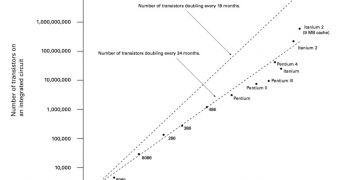Moore's Law, getting more and more transistors in a computer chip and getting out as much performance as possible, was the driving force behind the computer hardware industry for a number of years now. One problem that the whole CMOS based hardware manufacturers face is that they are reaching the limits of the materials they work with. So, after all these years the industry might for the first time be unable to follow any further Moore's Law, unless the engineers find solutions for power leakage problems, new ways to test processors and a more stable design.
According to the news site ComputerWorld, the 101 page long document written by leading engineers, International Technology Roadmap for Semiconductors (ITRS for short), states that a number of "grand challenges" are waiting just around the corner. Future computer hardware designs, more so in the case of the processors, will face several obstacles as the building materials are approaching the limits of their resistance. Among the obstacles listed there, three are noted to be the most concerning: test requirements for "increasingly complex devices", as the transistors are getting smaller and smaller "power leakage will become a major industry crisis in the long term" and the most worrying one, the increasingly chip variability.
All these problems are derived from Moore's Law, as a result of building complex electronic circuits that have to work at very small scales. As the complexity of the processors will grow over the next few years, the testing phase in their construction will become less and less reliable, being unable to assure the full testing of a chip before shipment. A computer science professor at the University of Virginia said that almost all non critical defects could be dealt by using specialized software at runtime.
"The power and reliability issues will vary by chip, which means that reactive, software-based solutions become very appealing," Kim Hazelwood says. "We will soon witness the ability to mask hardware issues using virtualization software moving out of the realm of innovation and into the realm of necessity. A virtual layer similar to Tortola allows the hardware and software to cooperate and results in a more efficient solution."

 14 DAY TRIAL //
14 DAY TRIAL //